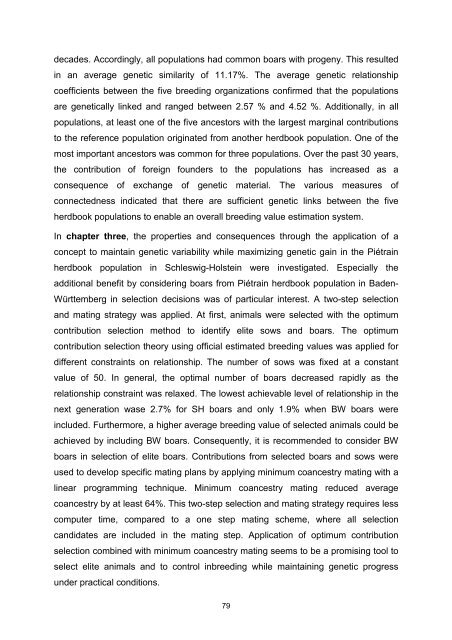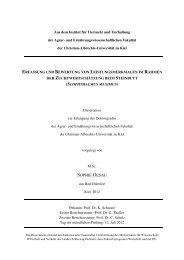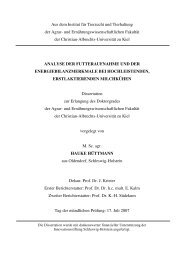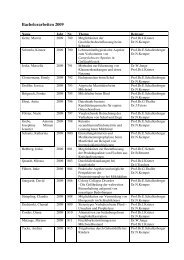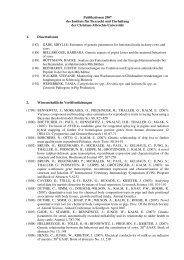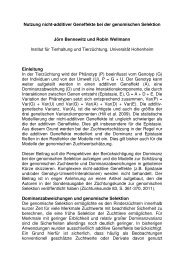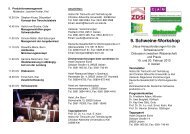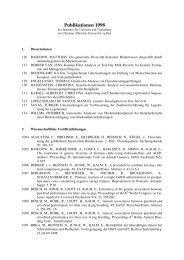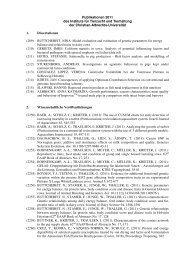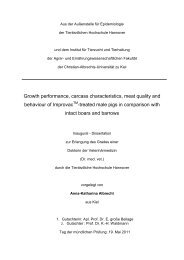Verena Gonzalez Lopez, 2011 - Institut für Tierzucht und Tierhaltung ...
Verena Gonzalez Lopez, 2011 - Institut für Tierzucht und Tierhaltung ...
Verena Gonzalez Lopez, 2011 - Institut für Tierzucht und Tierhaltung ...
Sie wollen auch ein ePaper? Erhöhen Sie die Reichweite Ihrer Titel.
YUMPU macht aus Druck-PDFs automatisch weboptimierte ePaper, die Google liebt.
decades. Accordingly, all populations had common boars with progeny. This resulted<br />
in an average genetic similarity of 11.17%. The average genetic relationship<br />
coefficients between the five breeding organizations confirmed that the populations<br />
are genetically linked and ranged between 2.57 % and 4.52 %. Additionally, in all<br />
populations, at least one of the five ancestors with the largest marginal contributions<br />
to the reference population originated from another herdbook population. One of the<br />
most important ancestors was common for three populations. Over the past 30 years,<br />
the contribution of foreign fo<strong>und</strong>ers to the populations has increased as a<br />
consequence of exchange of genetic material. The various measures of<br />
connectedness indicated that there are sufficient genetic links between the five<br />
herdbook populations to enable an overall breeding value estimation system.<br />
In chapter three, the properties and consequences through the application of a<br />
concept to maintain genetic variability while maximizing genetic gain in the Piétrain<br />
herdbook population in Schleswig-Holstein were investigated. Especially the<br />
additional benefit by considering boars from Piétrain herdbook population in Baden-<br />
Württemberg in selection decisions was of particular interest. A two-step selection<br />
and mating strategy was applied. At first, animals were selected with the optimum<br />
contribution selection method to identify elite sows and boars. The optimum<br />
contribution selection theory using official estimated breeding values was applied for<br />
different constraints on relationship. The number of sows was fixed at a constant<br />
value of 50. In general, the optimal number of boars decreased rapidly as the<br />
relationship constraint was relaxed. The lowest achievable level of relationship in the<br />
next generation wase 2.7% for SH boars and only 1.9% when BW boars were<br />
included. Furthermore, a higher average breeding value of selected animals could be<br />
achieved by including BW boars. Consequently, it is recommended to consider BW<br />
boars in selection of elite boars. Contributions from selected boars and sows were<br />
used to develop specific mating plans by applying minimum coancestry mating with a<br />
linear programming technique. Minimum coancestry mating reduced average<br />
coancestry by at least 64%. This two-step selection and mating strategy requires less<br />
computer time, compared to a one step mating scheme, where all selection<br />
candidates are included in the mating step. Application of optimum contribution<br />
selection combined with minimum coancestry mating seems to be a promising tool to<br />
select elite animals and to control inbreeding while maintaining genetic progress<br />
<strong>und</strong>er practical conditions.<br />
79


